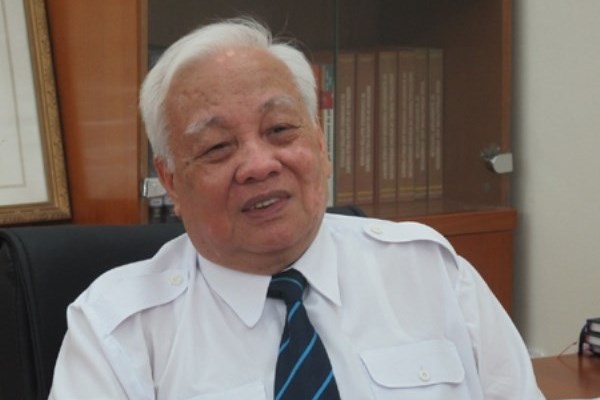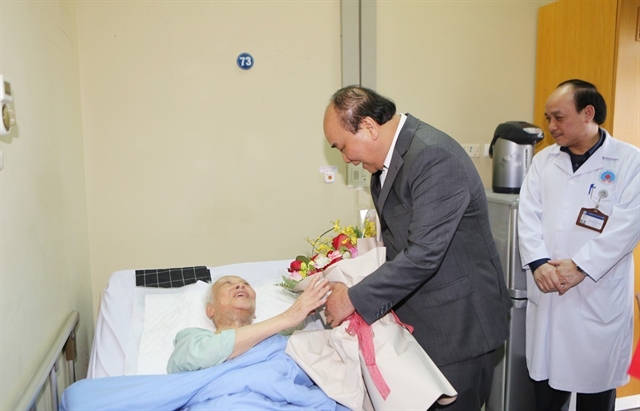
HÀ NỘI — Professor and academician Nguyễn Văn Hiệu, one of the most eminent scientists to make significant contributions to Việt Nam’s science and technology development, passed away on Sunday at the age of 84.
Associate Professor, PhD Nguyễn Hoài Châu, his younger brother, confirmed the news, saying that Hiệu’s health declined considerably in recent days after a period of treatment at the Friendship Hospital.
Hiệu was born on July 21, 1938, in Cầu Đơ, now part of Hà Cầu Ward, Hà Đông District, in the capital city of Hà Nội, to a family of Government employee parents with a total of 10 children – six sons and four daughters who all completed their university education, with six currently being PhD and two associate professors.
In an earlier interview, Hiệu said during the resistance war against the French colonisers, his family evacuated to a village in Thiệu Hoá District, the central province of Thanh Hoá.
“Although still a child, but my family was so poor, I applied to work as an assistant worker in a knitting workshop of a compatriot from Cự Đà Village who had evacuated here also. I saw that the productivity of a knitting machine was several hundred times higher than the productivity of a by-hand knitter, and since then I dreamed that one day, when we would win the resistance war, I would definitely apply to study in an engineering university,” he said, according to a career tribute to Hiệu from the Việt Nam Academy of Science and Technology released after his death.
In 1954, Hà Nội was liberated from French occupation, his family returned to Hà Đông District.
Back then the still-young Government had set up only three universities in Hà Nội – the Medical University, the University of Science Pedagogy and the University of the Literature Pedagogy, no university specialised in engineering yet.
However, as the University of Science Pedagogy had the Mathematics faculty which specialised in maths and physics, which was close enough to his dream field, he applied to this faculty, Hiệu said on the origin of his bond to physics.
Two years later, Hiệu graduated with a bachelor’s degree in physics with distinction, then became a lecturer at Hà Nội University (currently Việt Nam National University, Hà Nội).
In 1957, two Chinese scientists, Tsung-Dao Lee and Chen Ning Yang, earned the Nobel Prize in Physics “for their penetrating investigation of the so-called parity laws which has led to important discoveries regarding the elementary particles.” The above topic was extensively debated in many scientific publications in the former Soviet Union in 1958 and was introduced by the late Professor Tạ Quang Bửu in a lecture at Hà Nội National University.
Hiệu, then 20 years old, was drawn to this new breakthrough discovery, and had delved further into mathematics to gain a better understanding of the world’s leading scientists.
In 1960, he was sent to work at the Joint Institute for Nuclear Research in Dubna, Moscow, Soviet Union, which was considered among world-leading physics research centres at the time.
During this era, high energy physics was being pursued strongly in two directions: neutrino physics and strong interactions between particles. At the nuclear research institute, academician M. A. Markov led the efforts looking into the former area, while N. N. Bogolyubov and A.A. Logunov led the research into the latter.
Hiệu, then a Ph.D student, was under the direct guidance of both professors Markov and Logunov.
In April 1963, after two and a half years in Dubna with 12 published research papers on neutrino physics, Hiệu spent a few weeks writing his doctoral under the guidance of Prof. Markov. He successfully defended his doctoral thesis the same year.
At the same time, Prof. Logunov’s research projects were also progressing very well and promisingly, and Hiệu also was drawn into a new area with the Russian professor, mathematical analysis of strong force.
Logunov encouraged Hiệu to pursue this as another doctoral thesis, which he did, and finished it in a year under Logunov’s guidance.
He also defended his thesis successfully in 1964, to the complete consensus of the committee.
In 1968, Ph.D. Hiệu received his professorship of theoretical physics and mathematical physics at the Dubna institute and Lomonosov University at the age of 30.
A year later, Hiệu returned to Việt Nam as the Government was planning to set up various science and technology institutes.
The then Prime Minister Phạm Văn Đồng entrusted Hiệu to head the Institute of Physics, one of the two science institutes in Việt Nam at the time, laying the foundation for the development of basic sciences in Việt Nam.
He was one of the youngest members in history of the State Committee for Science and Technology.
In 1970, at an international physics conference in Kiev, Hiệu presented a report on his findings with Logunov, to the great interests of the delegations there.
After the conference, Logunov told him he could earn a Lenin Prize (which he eventually was honoured, but later in 1986), and urged him to return to the Soviet Union for a few more years to pursue more research, a tempting offer that Hiệu had to forgo as the works of the newly set up physics institute in Việt Nam needed him.
Still, he and Logunov, who later became Vice President of the USSR Academy of Sciences and Principal of the Lomonosov University, had cooperated on research into high energy particles, and their findings were granted patent from the Soviet Union in 1981.
On April 30, 1975, South Việt Nam was completely liberated from US forces’ presence. At the beginning of May 1975, Hiệu was appointed as a Member of the National Assembly and accompanied First Secretary of the Party Central Committee Lê Duẩn to go on an inspection trip of the southern provinces.
On July 4, 1975, the Central Bureau of South Việt Nam decided to establish the Southern Institute of Science and Technology under the Provisional Revolutionary Government of South Việt Nam and appointed Hiệu as Director.
With a very small team of scientists, he started the job of building a new institute from the ground up. In June 1976, after the unified country voted to elect the National Assembly for the first time, Hiệu returned to the North to take up the position of Deputy Director of the Việt Nam Academy of Sciences. In 1983, he became the Director.
From 1993, he served as the Director of the National Centre for Natural Science and Technology and the Director of the Institute of Materials Science. During these years, in addition to continuing his in-depth research on solid-state physics, he also made a special contribution to organising the introduction of yellow-flowered sage into mass planting in the northern mountainous region, creating a source of raw materials for industrial-scale production of anti-malarial drugs, serving people in remote and isolated areas and ethnic minorities.
In 1999, at the special invitation of the President of Việt Nam National University, Hà Nội, Professor and academician Nguyễn Văn Đạo, a colleague who had been with him for many years professionally, he returned again to the university where he used to study and teach at the beginning of his career as the Dean of the Faculty of Technology.
In 2004, the University of Technology, built as a model of a modern technology university within a multi-disciplinary university was established, and Hiệu was picked as its first Rector.
Professor Hiệu is among the few Vietnamese scientists with life-long career – his published works reached over 200 papers, covering many topics of physics and making an appearance on reputational international journals.
Hiệu was also known as one of the vocal proponents of reviewing salary regimes for the education sector, as well as his passion to elevate the quality of higher education in Việt Nam.
“The quality of education depends on a number of factors, but to me, there are two critical issues. First, the learners should be ones who like to study and have a righteous motivation for studying – to learn more, to become a skilled/talented person that can make a life for himself and contribute to the society. Second, the teachers need to be dedicated, and want to help students achieve their legitimate dreams and ambitions,” he said.
Even at the age of 70, Hiệu was working with young scientists in the new field of nano technology, and later still active as Chair of the Physics Association of Việt Nam and member of the presidium of the Central Committee of the Việt Nam Union of Science and Technology Associations.
He was also one of the people that laid the foundation for Việt Nam’s space and science technology through participating in the Soviet’s Interkosmos Space Programme.
Some notable honours Hiệu had received throughout his distinguished career include being an academician at the Third World Academy of Sciences, the Czech Academy of Sciences, and the Hồ Chí Minh Award, one of the highest honours bestowed by the Government of Việt Nam for works of cultural or/and scientific achievements, in 1996, and first-class Independence Order from the State of Việt Nam in 2009, the People’s Teacher title in 2010.
Professor Nguyễn Đại Hưng, current Chair of the Physics Association of Việt Nam, who was also once under Professor Hiệu’s guidance and had worked with him for several decades, said he received the news of his death when convening a meeting of the council for professorship.
“We were at a loss for words, truly sorry for this death. The council has held a brief tribute for Hiệu, many colleagues have burst into tears,” Hưng said. — VnExpress News

- Reduce Hair Loss with PURA D’OR Gold Label Shampoo
- Castor Oil Has Made a “Huge” Difference With Hair and Brow Growth
- Excessive hair loss in men: Signs of illness that cannot be subjective
- Dịch Vụ SEO Website ở Los Angeles, CA: đưa trang web doanh nghiệp bạn lên top Google
- Nails Salon Sierra Madre
 VnExpress News The News Gateway of Vietnam
VnExpress News The News Gateway of Vietnam





